
|
Astronomy Picture Of the Day (APOD)
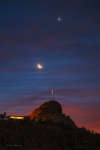 APOD: 2025 April 30 B A Happy Sky over Bufa Hill in Mexico
APOD: 2025 April 30 B A Happy Sky over Bufa Hill in Mexico
30.04.2025
Sometimes, the sky itself seems to smile. A few days ago, visible over much of the world, an unusual superposition of our Moon with the planets Venus and Saturn created just such an iconic facial expression.
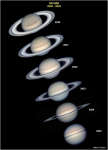 APOD: 2025 April 29 B Saturns Rings Appear to Disappear
APOD: 2025 April 29 B Saturns Rings Appear to Disappear
29.04.2025
Where are Saturn's ears? Galileo is credited, in 1610, as the first person to see Saturn's rings. Testing out Lipperhey's recently co-invented telescope, Galileo did not know what they were and so called them "ears". The mystery deepened in 1612, when Saturn's ears mysteriously disappeared.
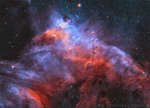 APOD: 2025 April 28 B Gum 37 and the Southern Tadpoles
APOD: 2025 April 28 B Gum 37 and the Southern Tadpoles
28.04.2025
This cosmic skyscape features glowing gas and dark dust clouds alongside the young stars of NGC 3572. A beautiful emission nebula and star cluster, it sails far southern skies within the nautical constellation Carina.
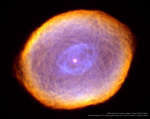 APOD: 2025 April 27 B IC 418: The Spirograph Nebula
APOD: 2025 April 27 B IC 418: The Spirograph Nebula
27.04.2025
What is creating the strange texture of IC 418? Dubbed the Spirograph Nebula for its resemblance to drawings from a cyclical drawing tool, planetary nebula IC 418 shows patterns that are not well understood. Perhaps they are related to chaotic winds from the variable central star, which changes brightness unpredictably in just a few hours.
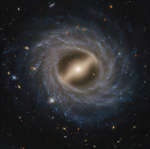 Barred Spiral Galaxy NGC 5335
Barred Spiral Galaxy NGC 5335
26.04.2025
This stunning portrait of NGC 5335 was captured by the Hubble Space Telescope. Some 170,000 light-years across and over 200 million light-years away toward the constellation Virgo, the magnificent spiral galaxy is seen face-on in Hubble's view.
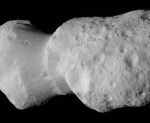 Asteroid Donaldjohanson
Asteroid Donaldjohanson
25.04.2025
Main belt asteroid 52246 Donaldjohanson is about 8 kilometers long and 3.5 kilometers across. On April 20, this sharp close-up of the asteroid was captured at a distance of about 1100 kilometers by the Lucy spacecraft's long range camera during its second asteroid encounter.
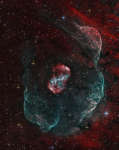 NGC 6164: A Dragon s Egg
NGC 6164: A Dragon s Egg
24.04.2025
Beautiful emission nebula NGC 6164 was created by a rare, hot, luminous O-type star, some 40 times as massive as the Sun. Seen at the center of the cosmic cloud, the star is a mere 3 to 4 million years old.
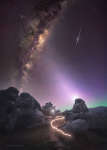 APOD: 2025 April 23 B An Almost Everything Sky
APOD: 2025 April 23 B An Almost Everything Sky
23.04.2025
This surprising sky has almost everything. First, slanting down from the upper left and far in the distance is the central band of our Milky Way Galaxy. More modestly, slanting down from the upper right and high in Earth's atmosphere is a bright meteor.
 APOD: 2025 April 22 B Terminator Moon: A Moonscape of Shadows
APOD: 2025 April 22 B Terminator Moon: A Moonscape of Shadows
22.04.2025
What's different about this Moon? It's the terminators. In the featured image, you can't directly see any terminator -- the line that divides the light of day from the dark of night. That's because the featured image is a digital composite of many near-terminator lunar strips over a full Moon.
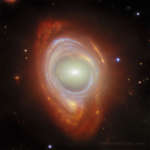 APOD: 2025 April 21 B Galaxy Lenses Galaxy from Webb
APOD: 2025 April 21 B Galaxy Lenses Galaxy from Webb
21.04.2025
Is this one galaxy or two? Although it looks like one, the answer is two. One path to this happening is when a small galaxy collides with a larger galaxy and ends up in the center. But in the featured image, something more rare is going on.
|
January February March April May June July August September October November December |
|||||||||||||||||||||||||||||||||||||||||||||||||